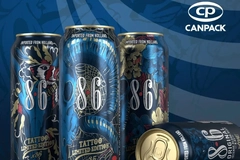Turning vineyard waste into biodegradable alternative for plastic film

A new study from South Dakota State University, US, has transformed grapevine canes into transparent, biodegradable films. The approach aims to reduce plastic waste pollution while creating new revenue streams for farmers and conserving natural resources.
Grapevine canes are major woody berry crops that generate substantial winter pruning waste, containing approximately 35% cellulose. In the study, published in Sustainable Food Technology, researchers extracted this cellulose using alkaline (10% potassium hydroxide) and bleaching (10% sodium chlorite) treatments. It was then solubilized in a zinc chloride solution, crosslinked with calcium ions, and plasticized with glycerol to develop films.
Srinivas Janaswamy, associate professor at South Dakota State University’s Department of Dairy and Food Science and the lead author of the research, tells Packaging Insights: “Plastic has become an essential part of daily life. It offers conveniences that make living easier, but its non-biodegradable nature is creating lasting environmental and health problems.”
He explains that grapevine cellulose-based films exhibit a lower environmental footprint compared to other biodegradable packaging options, especially regarding raw material sourcing, production costs, and biodegradability.
“Made from agricultural waste like grapevine prunings, our films eliminate the need for specific crop cultivation and promote waste valorization. Farmers typically spend around US$26 per ton to dispose of grapevine waste, a cost that can be avoided and potentially turned into income through incentives. Our film production process uses relatively mild chemicals, reducing environmental and safety concerns.”
Creating PE-like films
According to the study, the films biodegrade in 17 days in soil with 24% moisture content. The films also demonstrate optical clarity, with transparency between 83.70% and 84.30% per mm, and tensile strength ranging from 15.42 to 18.20 MPa.
 Repurposing underutilized grapevine canes as a cellulose source for packaging films enhances waste management.“The tensile strength of grapevine cellulose films is comparable to, and sometimes higher than, that of commercial low-density PE, usually between 7 and 25 MPa. This suggests that grapevine cellulose films could be a practical alternative to low-density PE in food packaging, especially for storage and transport,” Janaswamy highlights.
Repurposing underutilized grapevine canes as a cellulose source for packaging films enhances waste management.“The tensile strength of grapevine cellulose films is comparable to, and sometimes higher than, that of commercial low-density PE, usually between 7 and 25 MPa. This suggests that grapevine cellulose films could be a practical alternative to low-density PE in food packaging, especially for storage and transport,” Janaswamy highlights.
“Our study lays a strong foundation for developing grapevine cellulose film production. However, the process should be optimized for scale-up with maximum chemical recyclability to enhance sustainability.”
Additionally, he explains that the grapevine variety should be considered, as variations in cellulose content and composition can affect the film’s properties and its suitability for various applications.
“This helps ensure consistent quality and supply of the packaging material. Addressing this challenge may require investing in a pilot-scale production facility.”
Repurposing agricultural waste
The study aligns with Janaswamy’s previous research on extracting cellulose from multiple agricultural products, including avocado peels, soyhulls, alfalfa, switchgrass, spent coffee grounds, corncobs, and banana peels.
Janaswamy developed materials derived from them that resemble traditional plastic wrapping in appearance and texture. Each of the films varies in characteristics and properties.
“Our research on repurposing leftover farm materials helps create sustainable, eco-friendly packaging films and adds value to resources that would otherwise be discarded or unused,” he says.
“The hidden cost of plastic outweighs the comfort it provides. It’s time to replace plastic with eco-friendly and biodegradable alternatives.”











